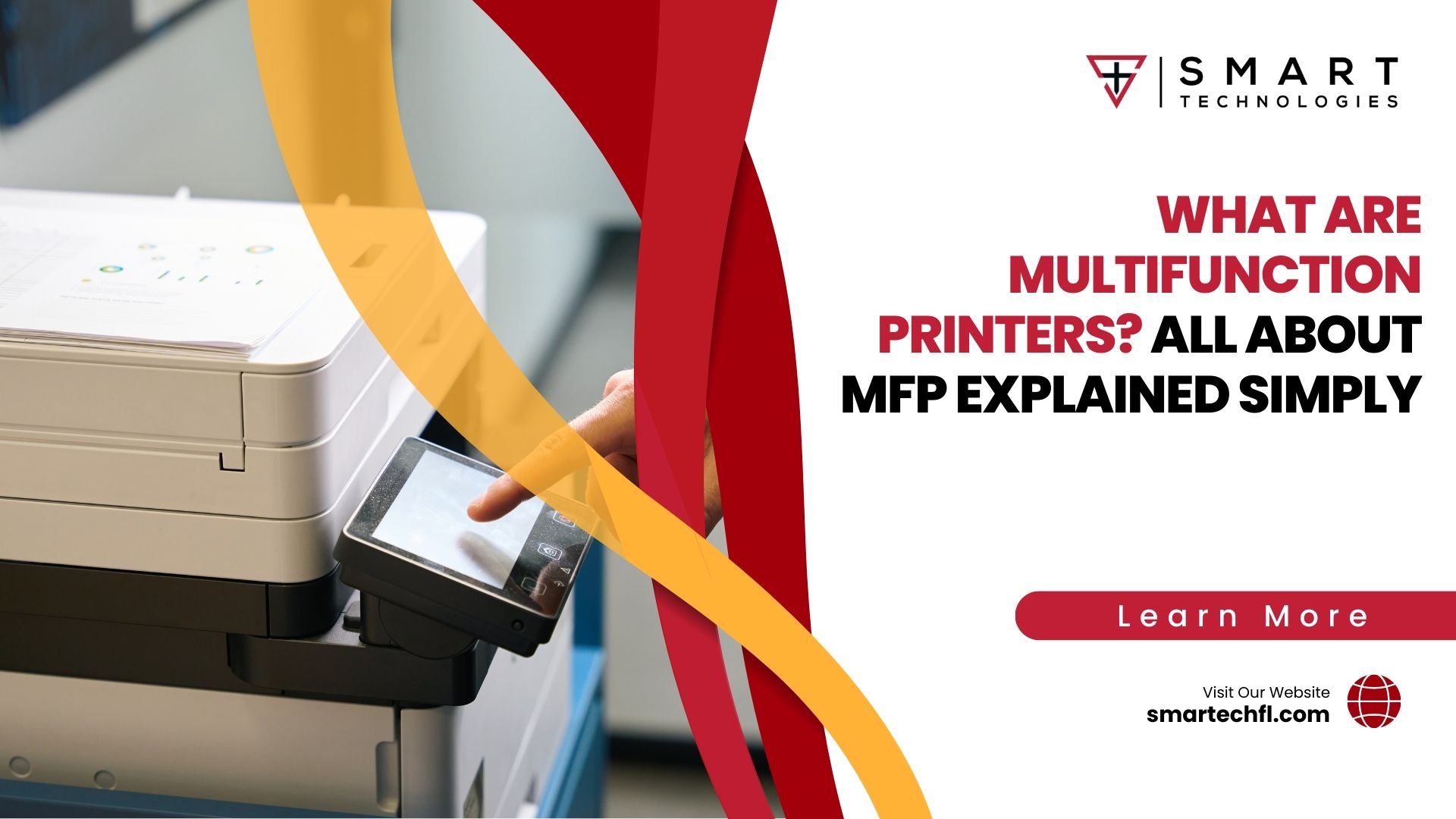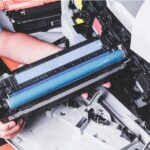Printer Waste Container: How to Manage and Dispose of It Properly
What is printer waste?
Printer waste refers to the residual materials left behind after printing, including ink cartridges, toner, paper, and other related components. These materials often end up in waste containers and contribute to environmental pollution if not managed properly.
The term also encompasses electronic waste from printers, such as circuit boards and cables, which can be hazardous.

Why is it important to manage and dispose of it properly?
Proper management and disposal of printer waste are vital aspects of maintaining environmental sustainability and responsible business practices. This process is not only about adhering to legal requirements but also about taking proactive steps to minimize the negative impact on the environment.
Preventing Environmental Contamination: Printers often contain harmful substances like heavy metals, chemicals, and other toxic materials. If not disposed of properly, these substances can leach into the soil and water, contaminating them and harming both wildlife and human health. Proper disposal methods ensure that these harmful substances are contained and treated, preventing them from entering the ecosystem.
Recycling and Reuse: Many components within printers are recyclable, such as plastics, metals, and electronic parts. By recycling these materials, we can reduce the need for new raw materials, thereby conserving natural resources. Reusing parts that are still functional also contributes to reducing waste, as it extends the life of existing materials rather than discarding them.
Reducing Overall Waste Content: The electronic waste generated by printers is a significant contributor to the global waste problem. Proper management of printer waste helps in segregating recyclable materials from non-recyclable ones, thus reducing the overall volume of waste that ends up in landfills.
Economic Benefits: Recycling and reusing printer components can be a cost-effective solution for businesses and individuals. By selling recyclable materials or purchasing refurbished parts, one can save money while also contributing to a sustainable solution.
Compliance with Regulations: Many countries have strict regulations regarding the disposal of electronic waste, including printers. Proper management ensures compliance with these laws, avoiding potential legal issues and fines.
Promoting Sustainable Practices: Proper disposal and recycling of printer waste align with the broader goals of sustainability and corporate social responsibility. It sends a positive message to customers, employees, and stakeholders that the organization is committed to environmental stewardship.
Educational Opportunities: By engaging in proper waste management practices, organizations can also educate their employees and the community about the importance of environmental protection. This education can foster a culture of responsibility and awareness that extends beyond the workplace.
In conclusion, the proper management and disposal of printer waste are multifaceted issues that encompass environmental protection, economic considerations, legal compliance, and social responsibility.
By adopting responsible practices, we can mitigate the harmful effects of printer waste on the environment, contribute to sustainable development, and create a positive impact on society as a whole.
The Environmental Impact of Printer Waste
The significance of electronics in waste
Electronic waste, including printers, contributes significantly to global pollution. The improper disposal of electronic components can lead to the release of toxic substances.
US EPA’s recycling guidelines offer comprehensive solutions for recycling electronics, including printer waste, to minimize their environmental impact.
The role of paper and cardboard in printer waste
Paper and cardboard constitute a large portion of printer waste. These materials are often discarded in waste containers without proper recycling.
The recycling of paper and cardboard is essential to reduce deforestation and energy consumption. It also aligns with the global effort to manage waste content responsibly.
Common Misconceptions about Printer Waste
Myths about recycling printer waste
Many people believe that all printer waste can be thrown into regular waste containers without any consequences. This misconception leads to improper disposal.
Education and awareness about the proper recycling methods are crucial to dispel these myths and provide the right solution for managing printer waste.
The reality of waste management
Electronic waste, including printers, contributes significantly to global pollution. The improper disposal of electronic components can lead to the release of toxic substances.
Waste management is a multifaceted process, especially in commercial buildings, where the volume and variety of waste can be substantial. It’s not merely about throwing things away; it involves careful sorting, recycling, and proper disposal.
The process begins with categorizing waste into recyclable, organic, and non-recyclable materials. Recycling efforts help conserve resources, while proper disposal ensures environmental safety. Commercial buildings often require a comprehensive guide to manage waste effectively, highlighting the importance of responsible practices and offering practical solutions.
Proper Disposal Techniques for Printer Waste Container
Importance of using proper containers
Using the right waste containers for different types of printer waste ensures that hazardous materials are handled safely.
Proper containers prevent cross-contamination and facilitate recycling, contributing to a sustainable solution for waste management.
Distinguishing between common waste and hazardous waste
Common waste includes paper and cardboard, while hazardous waste includes ink cartridges and electronic components.
Understanding the difference is essential for proper disposal, as hazardous waste requires special handling and cannot be mixed with common waste in the same container.
The role of facility managers and building owners
Facility managers and building owners play a vital role in implementing proper waste disposal techniques.
They must provide the right containers, educate occupants about proper disposal, and ensure compliance with regulations, all at a reasonable price.
Regulations and Standards
Overview of the 40 CFR Part 262 standards
- The 40 CFR Part 262 standards govern the management of hazardous waste, including certain types of printer waste.
- These regulations define what constitutes hazardous waste and outline the procedures for handling, storing, and disposing of it in the appropriate waste container.
How regulations impact waste disposal
- Regulations ensure that waste is managed in a way that protects both human health and the environment.
- Compliance with these standards is not just a legal obligation but also a responsible practice that contributes to a comprehensive solution for waste management.
This part of the article provides a detailed understanding of printer waste and its management, emphasizing the importance of proper disposal techniques, regulations, and the environmental impact. It incorporates the secondary keywords and links within the content as requested.
Advanced Management
Advanced Waste Management Techniques for Printer Waste encompass a comprehensive approach to handling, recycling, and disposing of waste generated from printers. This includes the waste from ink cartridges, toners, paper, and electronic components. Here’s an in-depth look at these techniques:
1. Recycling and Reusing Components
- Ink Cartridges and Toners: Many manufacturers and retailers offer recycling programs for ink cartridges and toners. These programs collect used cartridges and remanufacture them, reducing the need for new materials.
- Paper Recycling: Printers often generate paper waste, which can be recycled. Offices and print shops can implement paper recycling bins to collect waste paper, which can then be sent to recycling facilities.
2. Proper Disposal of Electronic Waste
- E-Waste Recycling Centers: Printers contain electronic components that can be hazardous if not disposed of properly. E-waste recycling centers specialize in handling these materials, ensuring that they are processed without harming the environment.
- Manufacturer Take-Back Programs: Some printer manufacturers offer take-back programs, where old printers can be returned for proper recycling or disposal.
3. Utilizing Eco-Friendly Printers
- Energy-Efficient Printers: Choosing printers that are energy-efficient reduces overall waste by consuming less power.
- Printers with Eco-Friendly Features: Some printers come with features that reduce waste, such as duplex printing, which prints on both sides of the paper, and ink-saving modes.
4. Implementing Managed Print Services (MPS)
- Monitoring Print Usage: MPS providers monitor print usage and help businesses reduce unnecessary printing, thereby minimizing waste.
- Supply Management: MPS also includes managing supplies like ink and paper, ensuring that they are used efficiently and that waste is minimized.
5. Educating and Training Staff
- Best Practices: Educating staff about best practices in printing can significantly reduce waste. This includes training on when and how to print, and how to handle printer waste.
- Promoting Digital Alternatives: Encouraging the use of digital documents instead of printing can also reduce waste.
6. Local Regulations and Compliance
- Understanding Local Regulations: Different regions may have specific regulations regarding the disposal of printer waste. Understanding and complying with these regulations ensures legal and responsible waste management.
- Certified Waste Handlers: Working with certified waste handlers who are knowledgeable about local regulations can ensure that printer waste is handled in compliance with the law.
7. Innovative Waste Reduction Technologies
- 3D Printing: Some industries are exploring 3D printing as a way to reduce waste by printing only what is needed.
- Smart Printers: Smart printers that can optimize print jobs, reduce errors, and minimize ink and paper usage are also contributing to waste reduction.
Advanced Waste Management Techniques for Printer Waste are essential in today’s environmentally conscious world. From recycling and reusing components to utilizing eco-friendly printers and implementing managed print services, these techniques offer a multifaceted approach to reducing printer waste.
By embracing these practices, businesses and individuals can contribute to a sustainable future, minimizing the environmental impact of printing. It’s not just about disposing of waste; it’s about rethinking how we print, what we print, and how we handle the waste that printing inevitably creates. It’s a continuous effort that requires awareness, commitment, and innovation.
Global Perspective on Waste Management
Waste management in developing countries
- Developing countries often face challenges in waste management, lacking the infrastructure for proper trash container handling and disposal.
- Solutions include investing in dumpster rentals, customizing waste bins to suit local needs, and educating the community about responsible waste disposal.
- Waste Mismanagement in Developing Countries: A Review provides insights into the global perspective on waste management, emphasizing the need for prompt action.
Challenges and solutions
- Challenges include limited access to dumpsters, lack of recycling facilities, and inadequate waste disposal methods.
- Solutions involve creating environmentally reliable waste management systems, offering temporary waste containers, and ensuring proper placement and loading of waste materials.
- Collaboration with leading providers and associations in the industry can foster better waste management practices.
What People Also Ask
No schema found.
Book a Meeting to Know How To Dispose Printer Waste Container
Conclusion
The importance of proper waste management extends beyond mere disposal. It encompasses a comprehensive approach to handling trash, from the selection of the right trash container to the responsible recycling of materials. Whether it’s choosing the right size of dumpsters for a construction project or opting for a rectangular wastebasket for kitchen waste, every decision plays a role in creating a sustainable environment.
Commercial buildings, households, and small businesses can all benefit from tailored waste management solutions. From heavy-duty wheel capacity bins to soft-close drawer systems, the options are vast. Brands like Amazon offer a wide variety of products, including open-top containers, custom junk removal solutions, and environmentally friendly recycling options.
Encouraging readers to adopt best practices in waste management is more than a call to action; it’s a commitment to our environment. By navigating the available options, understanding the features of different waste containers, and aligning with industry standards, we can collectively contribute to a cleaner, greener world.
Whether you’re settling for a tall swing trash container or exploring the latest in pull-out trash technology, remember that every choice matters. Depend on reliable providers, operate with consciousness, and shape a future where waste management is not just a duty but a reflection of our respect for the environment.











